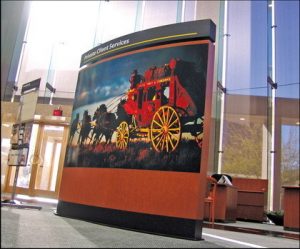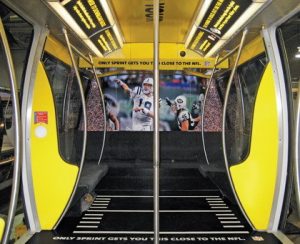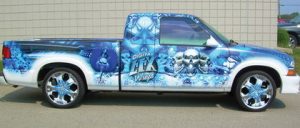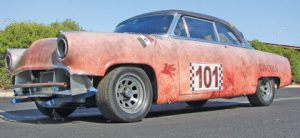Digital Printing
Cover Yourself
How to optimize your shop
Published
16 years agoon
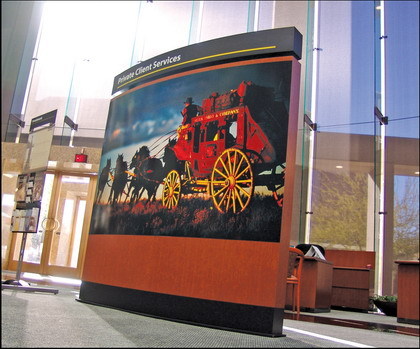
Compared to such digital-printing facets as printers, inks and direct-print media, lamination isn’t sexy. Whereas such improvements as more dynamic RIPs, white inks and more versatile media enable a broad array of digital applications, lamination’s capabilities don’t typically garner the same industry headlines or plaudits.
However, signshops shouldn’t devalue lamination. Despite improvements to printers and consumables, all but very short-term, digital-graphic installations probably require some type of protection from UV rays, heat, chemicals or an exuberant five-year-old after a sugar binge.
Of course, lamination adds to a graphic’s production cost, which varies based on the type of laminate used, the provider’s market and the job’s specific specs. But, these extra costs pale in comparison to the durability and appearance lamination offers.
Though incremental improvements have been made with raw-material engineering, laminator efficiency and such specialty items as textured laminates, effective lamination primarily remains a function of machine and material knowledge. Here, experts offer insights for perfecting this unglamorous, yet vital, fabrication process.
Rise of the machines
AdvertisementTo paraphrase Popeye, a laminator is what it is – it uses tensioned nip rollers to send the substrate through the system, apply a plastic topcoat, and expel it onto a table or take-up system. Although raw-material and roller improvements can enhance the process, the basic methodology has changed little.
Advanced Greig Laminators (AGL) Inc. (DeForest, WI) manufactures the Encore laminator series, which comprises four, 62-in.-wide models that can process material at 15 ft./min., and recently introduced the Compadre, another 62-in. laminator that features a built-in, video-training system on the machine’s front control panel.
Brian Franks, the company’s director of sales and marketing, jokingly described lamination as a “black art” – which means, to many sign-industry professionals, mystery unneccessarily shrouds the process. However, he broke down the process into four, basic considerations.
“The key factors are heat, speed, pressure and tension,” he said. “We’re trying to eliminate the ‘black art’ element and create a repeatable process that offers the best chance of success. Feedback controls that regulate these variables, coupled with in-depth, in-shop training, will provide best results.”
Franks also said running the laminator at speeds too fast for the operator to effectively handle will cause wasted product via ineffective processing. He also quipped, “With lamination, as in life, less tension is better. Too much tension in the unwind shaft can create upward curl, ripples and, possibly, laminate edge lifting.” According to Franks, too many service providers select the wrong laminate for a project, such as coating a cast film with a thermal laminate – an especially bad choice for an outdoor application.
Once a service provider perfects its lamination process, it can offer a significant value-added service – translation: revenue-generating opportunity. Though market prices may vary, Franks estimates the laminate material will cost, on average, 15 cents per sq. ft. for thermal laminates – pressure laminates cost more because they comprise an extra, release-liner layer.
AdvertisementIf the fabricator operating the laminator costs the company $15 per hour, laminating a 2 x 3-ft. print in 20 minutes costs less than $1.20 per sq. ft. when including labor and materials (laminator prices vary from a few thousand dollars to more than $50,000). However, because of the added durability and substance lamination provides, he estimates a service provider may command two- to four-fold more with this additional step.
Franks said his company’s improvements focus on simplicity and education. For example, a pneumatic system simplifies nip-roller adjustments compared to a traditional hand crank. And, the Compadre’s onboard video system includes 11 instructional videos that expedite the learning process for novices.
Neschen Americas – Seal & Neschen Brand Products (Elkridge, MD) manufactures Seal and Neschen brand hot and cold laminators and heat-activated, heat-set and pressure-sensitive laminating films, and backing films. David Conrad, the company’s senior equipment product manager, equates lamination with learning to drive a stick shift.
“There are many mechanical points to learn before becoming skilled with lamination, but there’s really no reason for anxiety,” Conrad said.
Conrad noted the importance of a well-trained lamination department to fabricating quality products, as well as reducing waste because of familiarity with materials and processes and the knowledge to bundle jobs for maximum labor and production efficiency. However, Conrad sometimes finds shops deficient in lamination training, which adversely impacts production schedules or prohibits undertaking certain projects.
AdvertisementAnd, Conrad reminds shop managers to consider their production layout: Any equipment that’s going to generate significant debris should be kept far away from a laminator. This is especially true when mounting a laminated graphic on glass or acrylic.”
Although printer, ink and base-film technologies continually progress, lamination should remain a staple for most long-term projects. As an example, Conrad said, although UV-ink flexibility continues to improve, he said, liquid laminates prevent chipping, scratching or scuffing during transit or after installation. Liquid laminates also prevent banding, or “lawnmower lines,” that may occur during high-speed production on a flatbed printer.
Among the subtle improvements that have simplified the lamination process, Conrad includes more preset selections and user-friendly controls that aid novice operators. For veteran lamination workers, more efficient nip mechanics and adjustable pressure settings, promote efficiency.
Daige inc. (Albertson, NY) manufactures cold-roll laminators and liquid-laminate products. Ike Harris, the company’s president, said numerous, market-driven innovations have enhanced its laminators’ functionality.
“Eight years ago, our laminators were designed for mounting, and customers told us they wanted lamination capabilities as well,” he said. Over the last several years, the company has upgraded its machines with silicone rollers, a motor with more horsepower and an automatic take-up reel.
“The key to consistent, successful lamination is proper setup, which includes threading the laminate between the rollers and ensuring smooth, taut materials against the top roller,” Harris said. “Second, make sure you have proper pressure with the top roller.”
Material messages
The laminate market has mushroomed in recent years, and protective films now suit virtually any application or desired finish. The graphic-laminate market essentially breaks down into five media types:
• Vinyl, the all-purpose topcoat, can be used for pressure or thermal laminators (thermal-vinyl laminates must be applied at sub-boiling temperatures) and offers strong durability.
• Polyester, thermal-only laminates with flexibility are ideal for tradeshow graphics and others that will be frequently removed. However, polyesters are recommended only for indoors; they have limited compatibility with solvent-ink prints.
• Polycarbonate, a pressure-only material, offers stout UV, vandal-ism and abrasion resistance, but, like its rigid-sheet brethren, it’s sometimes prone to discoloration and can be excessively rigid if not properly applied.
• Textured, pressure-only specialty materials provide unique finishes for tactile projects, as well as floor graphics and other applications that require slip resistance (anti-graffiti coatings could also be included under this umbrella).
• Liquid laminates typically incur less cost than lamination machines, but they sometimes offer less protection.
Pat Thiegs, technical service specialist for 3M’s Graphics Market Center (St. Paul, MN), cut his professional teeth working with laminator OEMs to develop lamination best practices for 3M’s electrostatic printers, and he has worked similarly with the company’s inkjet media. In addition to the standard reasons to laminate a print – UV, abrasion and chemical resistance, among others – he also noted that laminates provide additional installation and removal stability.
Tim Boxeth, 3M’s marketing manager, has observed a recent trend towards thinner laminates that offer increased conformability. Also, many new-generation laminates are softer and lack the “memory” that causes reversion to its original form after installation. However, Thiegs said thinner laminates require extra care because excessive film tension can stretch the laminate, and he recommends closely following owner’s manual specificiations for best practices.
Thiegs said, “The operator has to understand that applying too much pressure will create tight lamination in the shop, but it will be very prone to cracking when installed in the field.”
Mary Ann Kucera, product manager for MACtac (Stow, OH), said the advent of air-egress vinyl films have opened the vehicle-graphics arena to more shops and, in turn, increased the need for laminates that conform to the increasingly complex curves of late-model vehicles. These demanding applications require correct laminator tension settings and appropriate handling.
However, she advises against providers’ common assumption that a glossy overlaminate provides a one-size-fits-all solution: “Gloss finishes can make colors and images pop and offer strong color visibility and detail, but they’re best suited for applications where there’s moderate ambient lighting. In brightly lit environments, luster and matte finishes can diminish the glare, which is important for text-heavy graphic messages or those in wraparound installations, such as columns or tradeshow booths.”
Kucera said luster finishes have gained popularity because they effectively balance glare reduction and image fidelity, whereas designers sometimes choose matte finishes because they deliver a desired graphic effect.
Avery Dennison Graphics & Reflective Products Div.(Painesville, OH) Paul Roba, the company’s strategic-sales technical manager, said competition has produced different types of laminates. To match the feverish pace of the vehicle-graphics market, enhanced materials and methods have generated thinner, more conformable, overlaminate films that are usually warranted for five to seven years. Specialty films, such as graffiti-proof, textured or pearlescent media, have also gained greater attention.
Though ample demand exists for high-end laminates, many service providers must serve budget-conscious customers or those who execute frequently changed graphic campaigns. Therefore, Roba said value-engineered laminates have become a priority. For instance, a short-term graphic with little or no need for conformability doesn’t require a thin, cast overlaminate. With this in mind, the company is now offering a 3.2-mil, two-year, calendered laminate for POP and tradeshow applications.
Karen Buckleman, Neschen America’s consumables product manager, said market demand for “greener” materials has impacted the finishing market.
“Demand for sustainable digital graphics has challenged the printing industry to provide products that emit fewer VOCs or contain post-consumer, recycled content,” Buckleman said. According to her, improvements with waterbased, acrylic adhesives have made them competitive with solvent-based adhesives that once enjoyed a monopoly with outdoor applications. Such waterbased products offer low VOC and carbon-dioxide emissions. She also noted consumer interest in laminate products that contain recycled material. Such formulations are still in development, but Buckleman foresees them being introduced sometime in 2009.
Competition from Asian con-sumable manufacturers has also impacted the market. She said, “Although Asian products may cost less, their quality, support, service and lead times may be problematic for consumers.” Another trend Buckleman noted includes the direct printing to self-adhesive vinyl, which is subsequently coated with a cold overlaminate because vinyl is heat-sensitive and prone to shrinkage with thermal films.
Manufacturer List
Note: For additional manufacturers, consult the Buyers’ Guide at www.signweb.com
Laminators
Advanced Grieg Laminators (AGL)
Deforest, WI
800-276-2664
www.aglinc.com
Products: Encore, Compadre thermal or pressure laminators
|1989|
Mahwah, NJ
(201) 825-7400
www.codamount.com
Products: Cold-Mount® pressure laminators
Daige
Albertson, NY
(800) 645-3323
www.daige.com
Products: Quikmount 4 pressure laminator, EZ Glide liquid-laminate applicator
GBC
Addison, IL
(800) 723-4000
www.gbc.com
Products: SignMaker, Pinnacle, Arctic pressure laminators
Neschen Americas
Elkridge, MD
(800) 257-7325
www.neschenamericas.com
Products: Seal pouch and wide-format laminators, Neschen films and liquid laminates
Laminates
3M Graphics Market Center
St. Paul, MN
(800) 374-6772
www.3mgraphics.com
Products: Scotchcal™ vinyl, PVDF, polyolefin overlaminates
Avery Graphics
Painesville, OH
(800) 443-9380
www.averygraphics.com
Products: DOL vinyl, perforated-film overlaminates
Gerber Scientific Products
South Windsor, CT
(800) 222-7446
www.gspinc.com
Products: GerberGuard, StrikeGuard, UV Guard, Luster overlaminates
MACtac
Stow, OH
(866) 262-2822
www.mactac.com
Products: Permacolor, Permagard overlaminates
Roland DGA Corporation
Irvine, CA
(800) 542-2307
www.rolanddga.com
Products: PGM-OL cast, calendered and floor-marking overlaminates
SPONSORED VIDEO
Introducing the Sign Industry Podcast
The Sign Industry Podcast is a platform for every sign person out there — from the old-timers who bent neon and hand-lettered boats to those venturing into new technologies — we want to get their stories out for everyone to hear. Come join us and listen to stories, learn tricks or techniques, and get insights of what’s to come. We are the world’s second oldest profession. The folks who started the world’s oldest profession needed a sign.
You may like
Advertisement
Subscribe

Magazine
Get the most important news
and business ideas from Signsofthetimes Magazine.
Advertisement
Most Popular
-

 Tip Sheet1 week ago
Tip Sheet1 week agoAlways Brand Yourself and Wear Fewer Hats — Two of April’s Sign Tips
-

 Photo Gallery1 day ago
Photo Gallery1 day ago30 Snapshots of the 2024 ISA Sign Expo
-

 Ask Signs of the Times3 days ago
Ask Signs of the Times3 days agoWhy Are Signs from Canva so Overloaded and Similar?
-

 Real Deal1 week ago
Real Deal1 week agoA Woman Sign Company Owner Confronts a Sexist Wholesaler
-

 Benchmarks6 days ago
Benchmarks6 days ago6 Sports Venue Signs Deserving a Standing Ovation
-

 Editor's Note2 weeks ago
Editor's Note2 weeks agoWhy We Still Need the Women in Signs Award
-

 Women in Signs1 week ago
Women in Signs1 week ago2024 Women in Signs: Megan Bradley
-

 Photo Gallery1 week ago
Photo Gallery1 week ago21 Larry Albright Plasma Globes, Crackle Tubes and More

